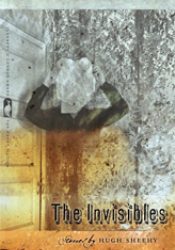
“Maybe, if you knew nothing about me, I could sit right next to you, and you would never have known it,” says Cynthia, the seventeen-year-old narrator of the title story in Hugh Sheehy’s debut collection, The Invisibles. “Not because I’m literally invisible, but because I don’t connect to other people. Some people just fall through the cracks. But most of us want to bee seen, so we make an effort.” The Invisibles is full of characters like Cynthia. They are people who would otherwise go unnoticed, except that Sheehy manages to capture the brief and gut-wrenching moments when these “invisibles” make an effort to be seen. Sheehy’s stories seem to glow in the dark, and reading them feels a little like watching fireflies light up at night.
There’s Dennis, the wealthy narrator of “Variations On A Theme,” who, after his fiancé Elise’s murder, becomes himself an “invisible” and moves to Cocoa Beach, concealing his past life as an investor and widower by adopting the identity of a lifeguard, “a simple beast of the seashore, a dependent of burrito shops.” Dennis becomes romantically involved with a young woman named Janine for no other reason than Janine bears an uncanny resemblance to the deceased Elise. Dennis goes as far as to attempt to mold Janine’s speech into a pattern more similar to Elise’s, hoping then that the likeness would be absolute:
“I am what I am,” I repeated. It was an old phrase of Elise’s, an extremely funny and sexy thing when spoken by a forthright young lady who wants you naked immediately. I thought that if I said it enough around Janine, she might start saying it. Imagining this gave me a sick, impish glee.
There’s Mason, the protagonist of “White Out,” who drops out of college, develops a cocaine habit, and severs ties with his family, choosing not to divulge his whereabouts or how he can be reached. Mason, however, watches the members of his family from afar, keeping tabs on their lives by regularly snooping around his brother’s personal blog. After a long night of drinking and snorting cocaine, Mason returns to the small townhouse in which he lives to find that his girlfriend is dead, her body bruised and “packed into the bathtub fully dressed:”
Her dirty feet hung over the edge. Someone had tucked her elbows in at her sides, titled her head back under the faucet. Her hazel eyes looked up emptily. Her clothes and hair were soaked, her pallid face rinsed with water, looking almost clean and innocent but for the marks on her cheeks where someone—a man, he first assumed then and simply came to believe afterward—had slapped her repeatedly to wake her up.
Later, with several meticulously-shopped-for Christmas presents in tow, Mason embarks on a surprise homecoming trip, but is stranded in the snow before ever reaching his parents’ home.
And there’s little Luke Dixon who, in a story titled “Meat and Mouth,” is stranded after school when his father neglects to retrieve him at the end of the day. With nothing to do but wait, Luke pretends to be Davey Schwartz, a student from class who bullies and torments Luke to no end. While Luke is pretending to be Davey, two grown bullies—grimy, grinning, knife-wielding men named “Meat” and “Mouth”—break onto school property and force both Luke and his terrified teacher into the basement. Luke’s father finally arrives—drunk and unsuspecting—only to have his throat slit by the tough who goes by “Meat.”
The body count doesn’t end with the abovementioned stories. Hugh Sheehy’s The Invisibles is full of persons disappeared, murdered, or otherwise tragically deceased; however, Sheehy focuses less on mourning than he does on the varied and eerie ways that these deaths manage to render those who are left behind—the living—invisible and ghostlike. Sheehy has utilized the most tantalizing elements from the thriller genre to craft stories that are literally hard to put down. Besides being engaging, Sheehy’s thrillers are original, warped additions to what can sometimes feel like an all-too-familiar and predictable genre. For example, in the story titled “Translation,” the protagonist, Marcus, functions as both hero and villain, but due to a psychotic break, he has forgotten his own identity. Marcus learns that he is a fired college professor and an ill-reputed scholar who was accused of falsely discovering and translating a lost tale of Ovid’s Metamorphoses. The tale in question ends with the chilling line, “This is why in the city Paphos, when they see an old person dancing, the say, ‘It is unhappy memory, not time, that makes one grow old.’”
Even as they frighten, Sheehy’s stories manage to do what all memorable stories do: they give startling insights into what it means to be a human being. In “shameful privacy,” a sheltered adolescent enjoys Fairy Tale Theater videos, which his mother brings home from the public library, and knows himself to be “drifting further and further” from “the norm.” The same character describes the rooms of his childhood home as having “a quality of attics, of stillness interrupted by sudden light.” That line also applies to the stories in The Invisibles. Reading these stories feels almost like intruding—like finding oneself in the wrong place at the wrong time, or like opening a door that was supposed to stay closed. The feeling of having trespassed is worth it, though, for the reader intrudes just as Sheehy’s characters call out to be seen, and in those moments moment, they appear, as if out of the darkness, on dazzling display.




